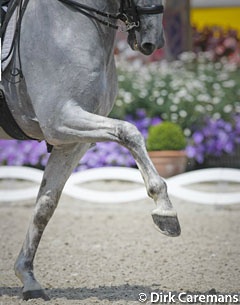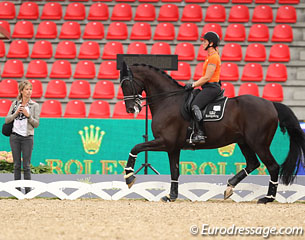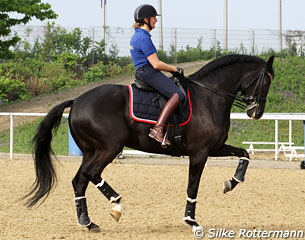
When you start putting on and taking off bandages on nine horses every day, one quickly realises that velcro boots have a lot going for them. I have now set out to discover which are better for the horse. Is it really necessary to cover the horse's legs, and if so which offer the better protection, boots or bandages?
Scientific Research on Boots and Bandages?!
Belgian veterinarian and European specialist in equine surgery, Dr Maarten Oosterlinck, advises that over the years a wide variety of boots and bandages have been designed and so far no consensus on their efficacy exists. "Some are merely chosen for aesthetic reasons, as they may ‘look great’ on horses’ limbs,” said Maarten.
Bandages and boots are mainly sold as ‘protective gear’, meaning that they intend to support the lower leg (limit fetlock extension) and/or protect the limb from trauma (as well from the surface the horse is performing on (e.g. Western and endurance horses), as external objects like bars (jumping horses), and interference of another limb.
“However, scientific information is very limited. Both boots and bandages have their own pros and cons," Oosterlinck explained.

“Whether or not this is a significant reduction in the prevention of injury is unknown. Limb forces are around 4000-6000 Newtons at walk and trot, respectively, meaning that the reported reduction is about 5% of the maximal vertical force,” Maarten added.
Oosterlinck stated that only a splint and one specific type of ‘tendon support boot’ (with a semi-rigid sheath and a hinge joint pivoting at the level of the fetlock) have been shown to support the fetlock joint, which may be useful during management of tendon/ligament injury and during rehabilitation (Smith et al. 2002).
Maarten believes that optimal conditioning and prevention against fatigue may be a more efficient means of limiting self-trauma and fetlock hyperextension than bandages and boots. With inconclusive evidence as to which is best, Maarten adds that boots may offer some more protection against trauma and are reportedly easier to apply, whereas improper application (overtightening!) of bandages may quickly result in rubs.

Going commando or leg bare might also pose risks and Maarten suggests that depending on the specific discipline, trauma from limb interference or from the environment may be very likely, and therefore, limb protection may be warranted.
“This is also dependent on the individual horse’s conformation, character, etc. On the other hand, in the absence of specific risk factors, some horses may be trained without boots or bandages without any problems….”
Bandages, a catch 22?
Dr. Lesley Hawson studied equitation science and is also well researched in the field of horse injury and prevention. She stated that the lower limbs of horses are very vulnerable to injury and that many practitioners recommend covering the lower limbs of horses for protective and support purposes.
“There is no doubt that covering the lower limbs will prevent penetrative injuries but the jury is out on whether many of the products on the market provide any protection against concussive or strain type injuries,” said Lesley.
So understanding that we can’t prevent against concussion/strain, i.e., internal injuries, what is the best means of protecting against the injuries we can prevent?

So great bandages are the go to, right? Not exactly! While bandages protect a horse against knocking itself, Lesley adds that due to the high insulation qualities provided by layers of soft material bandages are NOT recommended for use on horses that are engaged in long periods of work.
“Although studies have shown that bandaged legs do absorb more energy than unbandaged legs it is probably impossible to fit a traditional wrap bandage tight enough to reduce hyperflexion of the fetlock without affecting blood supply to the surface of the limb or possibly causing a bandage bow over the flexor tendons. Bandages will prevent minor scrapes and bruises but can be tricky to apply correctly.”
So bandages are great for protection in stables or to treat wounds, but not so good for training sessions. So lets look at boots

“They minimize the damage with horses that interfere with their own legs due to conformational or biomechanical faults. Splint or brushing boots are good for protecting horse’s legs when the horse is performing fast work or work that may induce them to hit themselves such as when they are learning to perform lateral work.”
Choosing the Right Leg Protection
So how do we choose boots for dressage horses?
“Boots used on dressage horses should cover the inside and back of the leg but can be open over the front of the cannon to facilitate heat dispersion," Hawson added.
Lesley admits that the ideal leg covering for the exercising horse would be light, resistant to penetration by sharp objects and able to protect the leg from concussive forces. It would promote effective heat transfer away from the soft tissue structures in the distal limb and prevent hyperextension beyond the fetlock’s normal range of motion.

So while there are good reasons to use leg protection on our horses there are also downsides. Despite the many claims of manufacturers there is little evidence that sports medicine or performance boots reduce sprain and strain injuries.
“The biomechanics of the horse is such that adding weight to the lower limbs has a profound effect on the efficiency of the horse’s legs. The horse must perform extra work to pull the limb off the ground into the swing phase of the stride and again to control the weighted leg while it is in flight. The pastern area also seems to be particularly sensitive to tactile stimulation so that the mere presence of a bandage or boot creates an increased flexion while in swing phase. This sounds like the horse’s movement might feel to be more active, but Clayton (2011) suggests that the flexion does not increase overall and therefore does not improve limb movement in terms of what is required in dressage," Hawson explained.
To Hawson it is also possible that the extra weight on the limbs may increase the “work out” for the muscles involved in the movements, but it unclear what the effects may be on the vital tendons and ligaments of the lower leg given they do not respond to exercise in the mature horse. Bandages or boots with deep linings will be heavier than unlined boots. Moist conditions will also make leg coverings heavier if they are made of absorbent materials.

In summary, horses have lived and worked without leg coverings for eons. While there is an increased risk of bumps and bangs arising on horses being worked without leg protection there is also sufficient evidence that some types of leg coverings may actually contribute to damage in the limb they are trying to protect.
by Sarah Warne for Eurodressage
Photos © Astrid Appels - Barbara Schnell - Silke Rottermann
Related Links
Taping For Talent
Keeping Horses Barefoot: a Healthy Horse From the Ground Up
Uniforms and Bandages Under Discussion at 2005 FEI Freestyle Forum